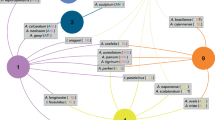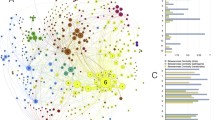Abstract
The study of host–parasite interactions is essential to understand the role of each host species in the parasitic transmission cycles in a given community. The use of ecological network highlights the patterns of interactions between hosts and parasites, allowing us to evaluate the underlying structural features and epidemiological roles of different species within this context. Through network analysis, we aimed to understand the epidemiological roles of mammalian hosts species (n = 67) and their parasites (n = 257) in the Pantanal biome. Our analysis revealed a modular pattern within the network, characterized by 14 distinct modules, as well as nestedness patterns within these modules. Some key nodes, such as the multi-host parasites Trypanosoma cruzi and T. evansi, connect different modules and species. These central nodes showed us that various hosts species, including those with high local abundances, contribute to parasite maintenance. Ectoparasites, such as ticks and fleas, exhibit connections that reflect their roles as vectors of certain parasites. Overall, our findings contribute to a comprehensive understanding of the structure of host–parasite interactions in the Pantanal ecosystem, highlighting the importance of network analysis as a tool to identifying the main transmission routes and maintenance of parasites pathways. Such insights are valuable for parasitic disease control and prevention strategies and shed light on the broader complexities of ecological communities.



Similar content being viewed by others
Data availability
All data generated or analyzed during this study are included in this published article and its supplementary information files.
References
Alcantara DMC, Ikeda P, Souza CS et al (2022) Multilayer networks assisting to untangle direct and indirect pathogen transmission in bats. Microb Ecol. https://doi.org/10.1007/s00248-022-02108-3
Almeida-Neto M, Ulrich W (2011) A straightforward computational approach for measuring nestedness using quantitative matrices. Environ Model Softw 26:173–178. https://doi.org/10.1016/j.envsoft.2010.08.003
Beckett SJ (2016) Improved community detection in weighted bipartite networks. R Soc Open Sci 3:140536. https://doi.org/10.1098/rsos.140536
Bezerra ELS, Machado IC, Mello MAR (2009) Pollination networks of oil-flowers: a tiny world within the smallest of all worlds. J Anim Ecol 78:1096–1101. https://doi.org/10.1111/j.1365-2656.2009.01567.x
Bezerra RHS, Bocchiglieri A (2022) Bat–parasite interaction networks in urban green areas in northeastern Brazil. Parasitology 1–7. https://doi.org/10.1017/S0031182022001718
Bianchi RD, Campos RC, Xavier-Filho NL et al (2014) Intraspecific, interspecific, and seasonal differences in the diet of three mid-sized carnivores in a large neotropical wetland. Acta Theriol (warsz) 59:13–23. https://doi.org/10.1007/s13364-013-0137-x
Blüthgen N (2010) Why network analysis is often disconnected from community ecology: a critique and an ecologist’s guide. Basic Appl Ecol 11:185–195. https://doi.org/10.1016/j.baae.2010.01.001
Cardoso TS, de Andreazzi CS, Junior AM, Gentile R (2021) Functional traits shape small mammal-helminth network: patterns and processes in species interactions. Parasitology 148:947–955. https://doi.org/10.1017/S0031182021000640
Csardi G, Nepusz T (2006) The igraph software package for complex network research. InterJournal, Complex Systems 1695:1–9
Dallas TA, Han BA, Nunn CL et al (2019) Host traits associated with species roles in parasite sharing networks. Oikos 128:23–32. https://doi.org/10.1111/oik.05602
de Macedo GC, Herrera HM, de Oliveira Porfírio GE et al (2022a) Brucellosis in the Brazilian Pantanal wetland: threat to animal production and wildlife conservation. Braz J Microbiol 53:2287–2297. https://doi.org/10.1007/s42770-022-00831-0
de Macedo GC, Herrera HM, Jansen AM et al (2022b) Saúde e conservação dos animais silvestres na natureza. Boletim do Museu Paraense Emílio Goeldi - Ciências Naturais 16:459–526. https://doi.org/10.46357/bcnaturais.v16i3.806
de Sousa KCM, Calchi AC, Herrera HM et al (2017) Anaplasmataceae agents among wild mammals and ectoparasites in Brazil. Epidemiol Infect 145:3424–3437. https://doi.org/10.1017/S095026881700245X
Delmas E, Besson M, Brice M-H et al (2019) Analysing ecological networks of species interactions. Biol Rev 94:16–36. https://doi.org/10.1111/brv.12433
Demoner LC, Rubini AS, Paduan KS et al (2013) Investigation of tick vectors of Hepatozoon canis in Brazil. Ticks Tick Borne Dis 4:542–546. https://doi.org/10.1016/j.ttbdis.2013.07.006
Desbiez ALJ, Bodmer RE, Tomas WM (2010) Mammalian densities in a neotropical wetland subject to extreme climatic events. Biotropica 42:372–378. https://doi.org/10.1111/j.1744-7429.2009.00601.x
Dormann CF (2011) How to be a specialist? Quantifying specialisation in pollination networks. Network Biology 1:1–20
Dormann CF, Gruber B, Fründ J (2008) Introducing the bipartite package: analysing ecological networks. R News 8:8–11
Felix GM, Pinheiro RBP, Poulin R, et al (2022a) The compound topology of host–parasite networks is explained by the integrative hypothesis of specialization. Oikos 2022:. https://doi.org/10.1111/oik.08462
Felix GM, Pinheiro RBP, Jorge LR, et al (2022b). A framework for hierarchical compound topologies in species interaction networks. Oikos e09538, https://doi.org/10.1111/oik.09538
Flores CO, Valverde S, Weitz JS (2013) Multi-scale structure and geographic drivers of cross-infection within marine bacteria and phages. ISME J 7:520–532. https://doi.org/10.1038/ismej.2012.135
Freeman LC (1977) A set of measures of centrality based on betweenness. Sociometry 40:35. https://doi.org/10.2307/3033543
Freeman LC (1978) Centrality in social networks conceptual clarification. Soc Networks 1:215–239. https://doi.org/10.1016/0378-8733(78)90021-7
Gonçalves LR, Herrera HM, Nantes WAG et al (2020) Genetic diversity and lack of molecular evidence for hemoplasma cross-species transmission between wild and synanthropic mammals from Central-Western Brazil. Acta Trop 203:105303. https://doi.org/10.1016/j.actatropica.2019.105303
Gonçalves LR, Paludo G, Bisol TB et al (2021) Molecular detection of piroplasmids in synanthropic rodents, marsupials, and associated ticks from Brazil, with phylogenetic inference of a putative novel Babesia sp. from white-eared opossum (Didelphis albiventris). Parasitol Res 120:3537–3546. https://doi.org/10.1007/s00436-021-07284-8
Guimarães PR (2020) The structure of ecological networks across levels of organization. Annu Rev Ecol Evol Syst 51:433–460. https://doi.org/10.1146/annurev-ecolsys-012220-120819
Hembry DH, Raimundo RLG, Newman EA et al (2018) Does biological intimacy shape ecological network structure? A test using a brood pollination mutualism on continental and oceanic islands. J Anim Ecol 87:1160–1171. https://doi.org/10.1111/1365-2656.12841
Herrera HM, Dávila AMR, Norek A et al (2004) Enzootiology of Trypanosoma evansi in Pantanal, Brazil. Vet Parasitol 125:263–275. https://doi.org/10.1016/j.vetpar.2004.07.013
Herrera HM, Rademaker V, Abreu UGP et al (2007) Variables that modulate the spatial distribution of Trypanosoma cruzi and Trypanosoma evansi in the Brazilian Pantanal. Acta Trop 102:55–62. https://doi.org/10.1016/j.actatropica.2007.03.001
Herrera HM, Rocha FL, Lisboa CV et al (2011) Food web connections and the transmission cycles of Trypanosoma cruzi and Trypanosoma evansi (Kinetoplastida, Trypanosomatidae) in the Pantanal Region, Brazil. Trans R Soc Trop Med Hyg 105:380–387. https://doi.org/10.1016/j.trstmh.2011.04.008
Júnior LDF, De Araújo WS, Falcão LAD (2020) Structure of the interaction networks between bats (Mammalia: Chiroptera) and ectoparasite flies (Diptera: Streblidae, Nycteribiidae) on a latitudinal gradient. Acta Chiropt 22:187. https://doi.org/10.3161/15081109ACC2020.22.1.018
Leung TLF, Koprivnikar J (2019) Your infections are what you eat: how host ecology shapes the helminth parasite communities of lizards. J Anim Ecol 88:416–426. https://doi.org/10.1111/1365-2656.12934
Lewinsohn TM, Inácio Prado P, Jordano P et al (2006) Structure in plant-animal interaction assemblages. Oikos 113:174–184. https://doi.org/10.1111/j.0030-1299.2006.14583.x
Martín González AM, Dalsgaard B, Olesen JM (2010) Centrality measures and the importance of generalist species in pollination networks. Ecol Complex 7:36–43. https://doi.org/10.1016/j.ecocom.2009.03.008
Mello MAR, Bezerra ELS, Machado IC (2013) Functional roles of Centridini oil bees and Malpighiaceae oil flowers in biome-wide pollination networks. Biotropica 45:45–53. https://doi.org/10.1111/j.1744-7429.2012.00899.x
Mello MAR, Rodrigues FA, Costa LDF et al (2015) Keystone species in seed dispersal networks are mainly determined by dietary specialization. Oikos 124:1031–1039. https://doi.org/10.1111/oik.01613
Mello MAR, Felix GM, Pinheiro RBP et al (2019) Insights into the assembly rules of a continent-wide multilayer network. Nat Ecol Evol 3:1525–1532. https://doi.org/10.1038/s41559-019-1002-3
Morris RJ, Gripenberg S, Lewis OT, Roslin T (2014) Antagonistic interaction networks are structured independently of latitude and host guild. Ecol Lett 17:340–349. https://doi.org/10.1111/ele.12235
Pinheiro RBP, Felix GMF, Dormann CF, Mello MAR (2019) A new model explaining the origin of different topologies in interaction networks. Ecology 100:. https://doi.org/10.1002/ecy.2796
Pinheiro RBP, Felix GMF, Lewinsohn TM (2022) Hierarchical compound topology uncovers complex structure of species interaction networks. J Anim Ecol 91:2248–2260. https://doi.org/10.1111/1365-2656.13806
Porfirio G, Sarmento P, Foster V, Fonseca C (2017) Activity patterns of jaguars and pumas and their relationship to those of their potential prey in the Brazilian Pantanal. Mammalia 81:401–404. https://doi.org/10.1515/mammalia-2015-0175
Porfirio GEO, Santos FM, de Macedo GC et al (2018) Maintenance of Trypanosoma cruzi. T evansi and Leishmania spp by domestic dogs and wild mammals in a rural settlement in Brazil-Bolivian border. Int J Parasitol Parasites Wildl 7:398–404
Poulin R (2007) Evolutionary ecology of parasites. Princetin University, New Jersey, p 342
Queiroz JA, Diniz UM, Vázquez DP et al (2021) Bats and hawkmoths form mixed modules with flowering plants in a nocturnal interaction network. Biotropica 53:596–607. https://doi.org/10.1111/btp.12902
R Core Team (2022) R: a language and environment for statistical computing. R foundation for statistical computing, Vienna, Austria
Rademaker V, Herrera HM, Raffel TR et al (2009) What is the role of small rodents in the transmission cycle of Trypanosoma cruzi and Trypanosoma evansi (Kinetoplastida Trypanosomatidae)? A study case in the Brazilian Pantanal. Acta Trop 111:102–107. https://doi.org/10.1016/j.actatropica.2009.02.006
Ramírez-Hernández A, Uchoa F, de Azevedo Serpa MC (2020) Capybaras (Hydrochoerus hydrochaeris) as amplifying hosts of Rickettsia rickettsii to Amblyomma sculptum ticks: evaluation during primary and subsequent exposures to R. rickettsii infection. Ticks Tick Borne Dis 11:101463. https://doi.org/10.1016/j.ttbdis.2020.101463
Santos FM, Sano NY (2022a) Functional role of small mammals in protozoan transmission networks in Brazilian biomes. Hystrix, the Italian Journal of Mammalogy 33:107–112. https://doi.org/10.4404/hystrix-00495-2021
Santos FM, Sano NY (2022b) Parasite association in non-volant small mammals in Brazil. Community Ecol 23:129–136. https://doi.org/10.1007/s42974-022-00080-z
Santos FM, de Sousa KCM, Sano NY et al (2021) Relationships between vector-borne parasites and free-living mammals at the Brazilian Pantanal. Parasitol Res 120:1003–1010. https://doi.org/10.1007/s00436-020-07028-0
Santos FM, Sano NY, Liberal SC et al (2022) The influence of abiotic and biotic variables on the patent parasitemias of Trypanosoma spp. in Thrichomys fosteri (Rodentia: Echimyidae) in the southern Pantanal. Parasitol Res 121:1719–1724. https://doi.org/10.1007/s00436-022-07522-7
Sarmento R, Alves-Costa CP, Ayub A, Mello MAR (2014) Partitioning of seed dispersal services between birds and bats in a fragment of the Brazilian Atlantic Forest. Zoologia (curitiba) 31:245–255. https://doi.org/10.1590/S1984-46702014000300006
Urbieta GL, Graciolli G, da Cunha TV (2022) Review of studies about bat-fly interactions inside roosts, with observations on partnership patterns for publications. Parasitol Res 121:3051–3061. https://doi.org/10.1007/s00436-022-07635-z
Vázquez DP, Melián CJ, Williams NM et al (2007) Species abundance and asymmetric interaction strength in ecological networks. Oikos 116:1120–1127. https://doi.org/10.1111/j.2007.0030-1299.15828.x
Vitorino BD, da Frota AVB, Maruyama PK et al (2022) Influence of sampling methods on the description of a neotropical seed dispersal network. Acta Oecologica 114:103805. https://doi.org/10.1016/j.actao.2021.103805
Acknowledgements
We thank the institutions that provide the structure to carried out our work: Federal University of Mato Grosso do Sul, Dom Bosco Catholic University and Homem Pantaneiro Institution.
Funding
This work was supported by the following Brazilian research agencies: Coordenação de Aperfeiçoamento de Nível Superior (CAPES – Finance code 001), Conselho Nacional de Desenvolvimento Científico e Tecnológico (CNPq), and Fundação de Apoio ao Desenvolvimento do Ensino, Ciência e Tecnologia do Estado de Mato Grosso do Sul (FUNDECT). FMS received a fellowship from CAPES (88887.369261/2019–00). NYS received a fellowship from Project Rede Pantanal from the Ministry of Science, Technology and Innovations of Brazil (FINEP Grant No. 01.20.0201.00). HMH is a fellowship researcher from CNPq (Productivity Scholarship-Level 2).
Author information
Authors and Affiliations
Contributions
The conceptualization started by NYS, HMH, and FMS, while data curation were carried out by GEOP and GCM. Formal analysis was made by NYS and FMS, where Fig. 1 was made by FMS, and tables were made and formatted by NYS, with some advises of HMH and GEOP. HMH was responsible for the funding acquisition. The main manuscript was written by NYS, with editing of FMS. All authors reviewed the manuscript.
Corresponding author
Ethics declarations
Ethics approval
Not applicable.
Competing interests
The authors declare no competing interests.
Additional information
Section Editor: Elizabeth Warburton.
Publisher's Note
Springer Nature remains neutral with regard to jurisdictional claims in published maps and institutional affiliations.
Supplementary Information
Below is the link to the electronic supplementary material.
Rights and permissions
Springer Nature or its licensor (e.g. a society or other partner) holds exclusive rights to this article under a publishing agreement with the author(s) or other rightsholder(s); author self-archiving of the accepted manuscript version of this article is solely governed by the terms of such publishing agreement and applicable law.
About this article
Cite this article
Sano, N.Y., Herrera, H.M., Porfirio, G.E.d. et al. Exploring interactions between parasites and their hosts in the Pantanal floodplain using an ecological network approach. Parasitol Res 123, 128 (2024). https://doi.org/10.1007/s00436-024-08140-1
Received:
Accepted:
Published:
DOI: https://doi.org/10.1007/s00436-024-08140-1




